
North Pacific humpback whales, a mother and calf pair swim closely together just under the surface of the ocean. The calf will remain with its mother for about a year, migrating from Hawaii to Alaska to feed on herring.
Species: Humpback whale, Megaptera novaeangliae
Location: Maui, Hawaii
Image ID: 00140
Species: Humpback whale, Megaptera novaeangliae
Location: Maui, Hawaii
Image ID: 00140

Humpback whale breaching, near Molokai, Hawaii. Megaptera novaeangliae. It is suspected the breaching often has a communicative purpose which depends on the behavioral context of the moment.
Species: Humpback whale, Megaptera novaeangliae
Location: Maui, Hawaii
Image ID: 00205
Species: Humpback whale, Megaptera novaeangliae
Location: Maui, Hawaii
Image ID: 00205
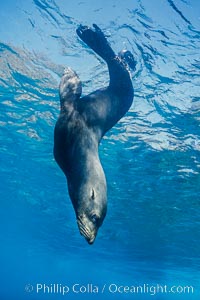
Guadalupe fur seal, floating upside down under the ocean's surface at Guadalupe Island, watching the photographer and looking for passing predators.
Species: Guadalupe fur seal, Arctocephalus townsendi
Location: Guadalupe Island (Isla Guadalupe), Baja California, Mexico
Image ID: 02114
Species: Guadalupe fur seal, Arctocephalus townsendi
Location: Guadalupe Island (Isla Guadalupe), Baja California, Mexico
Image ID: 02114
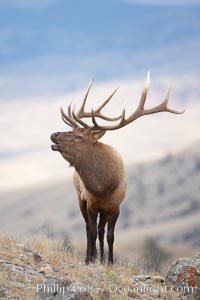
Male elk bugling during the fall rut. Large male elk are known as bulls. Male elk have large antlers which are shed each year. Male elk engage in competitive mating behaviors during the rut, including posturing, antler wrestling and bugling, a loud series of screams which is intended to establish dominance over other males and attract females.
Species: Elk, Cervus canadensis
Location: Mammoth Hot Springs, Yellowstone National Park, Wyoming
Image ID: 19693
Species: Elk, Cervus canadensis
Location: Mammoth Hot Springs, Yellowstone National Park, Wyoming
Image ID: 19693
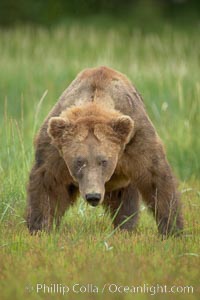
Full grown, mature male coastal brown bear boar (grizzly bear) in sedge grass meadows.
Species: Brown bear, Ursus arctos
Location: Lake Clark National Park, Alaska
Image ID: 19134
Species: Brown bear, Ursus arctos
Location: Lake Clark National Park, Alaska
Image ID: 19134

A Florida manatee, or West Indian Manatee, swims slowly through the clear waters of Crystal River.
Species: West indian manatee, Trichechus manatus
Location: Three Sisters Springs, Crystal River, Florida
Image ID: 02696
Species: West indian manatee, Trichechus manatus
Location: Three Sisters Springs, Crystal River, Florida
Image ID: 02696
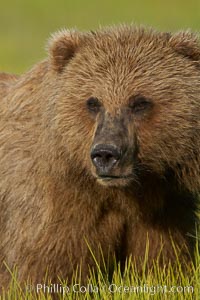
Portrait of a young brown bear, pausing while grazing in tall sedge grass. Brown bears can consume 30 lbs of sedge grass daily, waiting weeks until spawning salmon fill the rivers.
Species: Brown bear, Ursus arctos
Location: Lake Clark National Park, Alaska
Image ID: 19135
Species: Brown bear, Ursus arctos
Location: Lake Clark National Park, Alaska
Image ID: 19135

Galapagos shark swims over a reef in the Galapagos Islands, with schooling fish in the distance.
Species: Galapagos shark, Carcharhinus galapagensis
Location: Wolf Island, Galapagos Islands, Ecuador
Image ID: 16240
Species: Galapagos shark, Carcharhinus galapagensis
Location: Wolf Island, Galapagos Islands, Ecuador
Image ID: 16240

A great white shark swims through the clear waters of Isla Guadalupe, far offshore of the Pacific Coast of Mexico's Baja California. Guadalupe Island is host to a concentration of large great white sharks, which visit the island to feed on pinnipeds and use it as a staging area before journeying farther into the Pacific ocean.
Species: Great white shark, Carcharodon carcharias
Location: Guadalupe Island (Isla Guadalupe), Baja California, Mexico
Image ID: 19465
Species: Great white shark, Carcharodon carcharias
Location: Guadalupe Island (Isla Guadalupe), Baja California, Mexico
Image ID: 19465

Brown booby flying over Rose Atoll at sunset, with dark colorful storm clouds and other birds in the background.
Species: Brown booby, Sula leucogaster
Location: Rose Atoll National Wildlife Sanctuary, American Samoa
Image ID: 00914
Species: Brown booby, Sula leucogaster
Location: Rose Atoll National Wildlife Sanctuary, American Samoa
Image ID: 00914

A white tern, or fairy tern, alights on a branch at Rose Atoll in American Samoa.
Species: Fairy tern, Gygis alba
Location: Rose Atoll National Wildlife Sanctuary, American Samoa
Image ID: 00871
Species: Fairy tern, Gygis alba
Location: Rose Atoll National Wildlife Sanctuary, American Samoa
Image ID: 00871

A blue shark swims through the open ocean in search of prey, backlit by the sunset.
Species: Blue shark, Prionace glauca
Location: San Diego, California
Image ID: 02286
Species: Blue shark, Prionace glauca
Location: San Diego, California
Image ID: 02286
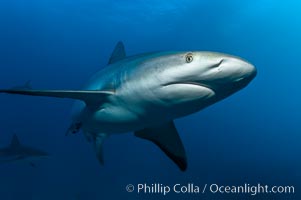
Caribbean reef shark, ampullae of Lorenzini visible on snout.
Species: Caribbean reef shark, Carcharhinus perezi
Location: Bahamas
Image ID: 10550
Species: Caribbean reef shark, Carcharhinus perezi
Location: Bahamas
Image ID: 10550

Bull elephant seal exits the water to retake his position on the beach. He shows considerable scarring on his chest and proboscis from many winters fighting other males for territory and rights to a harem of females. Sandy beach rookery, winter, Central California.
Species: Elephant seal, Mirounga angustirostris
Location: Piedras Blancas, San Simeon, California
Image ID: 15458
Species: Elephant seal, Mirounga angustirostris
Location: Piedras Blancas, San Simeon, California
Image ID: 15458

The bright orange garibaldi fish, California's state marine fish, is also clownlike in appearance.
Species: Garibaldi, Hypsypops rubicundus
Location: California
Image ID: 02416
Species: Garibaldi, Hypsypops rubicundus
Location: California
Image ID: 02416

Guadalupe fur seal pup sits on brown rocks along the coastline of Guadalupe Island.
Species: Guadalupe fur seal, Arctocephalus townsendi
Location: Guadalupe Island (Isla Guadalupe), Baja California, Mexico
Image ID: 02441
Species: Guadalupe fur seal, Arctocephalus townsendi
Location: Guadalupe Island (Isla Guadalupe), Baja California, Mexico
Image ID: 02441
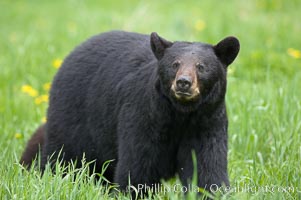
Black bear walking in a grassy meadow. Black bears can live 25 years or more, and range in color from deepest black to chocolate and cinnamon brown. Adult males typically weigh up to 600 pounds. Adult females weight up to 400 pounds and reach sexual maturity at 3 or 4 years of age. Adults stand about 3' tall at the shoulder.
Species: American black bear, Ursus americanus
Location: Orr, Minnesota
Image ID: 18744
Species: American black bear, Ursus americanus
Location: Orr, Minnesota
Image ID: 18744

A huge blue whale swims through the open ocean in this aerial photograph. The blue whale is the largest animal ever to live on Earth.
Species: Blue whale, Balaenoptera musculus
Image ID: 02169
Species: Blue whale, Balaenoptera musculus
Image ID: 02169

Ocean sunfish schooling, open ocean near San Diego.
Species: Ocean sunfish, Mola mola
Location: San Diego, California
Image ID: 03562
Species: Ocean sunfish, Mola mola
Location: San Diego, California
Image ID: 03562

North Pacific humpback whale, escort in competitive group makes fast close pass.
Species: Humpback whale, Megaptera novaeangliae
Location: Maui, Hawaii
Image ID: 06057
Species: Humpback whale, Megaptera novaeangliae
Location: Maui, Hawaii
Image ID: 06057

Aerial photo of gray whale calf and mother. This baby gray whale was born during the southern migration, far to the north of the Mexican lagoons of Baja California where most gray whale births take place.
Species: Gray whale, Eschrichtius robustus
Location: San Clemente, California
Image ID: 29017
Species: Gray whale, Eschrichtius robustus
Location: San Clemente, California
Image ID: 29017

Western gull, early morning pink sky.
Species: Western gull, Larus occidentalis
Location: La Jolla, California
Image ID: 18394
Species: Western gull, Larus occidentalis
Location: La Jolla, California
Image ID: 18394

Northern fur seal swims through the cold waters and kelp forest of San Miguel Island, in California's northern Channel Islands.
Species: Northern fur seal, Callorhinus ursinus
Location: San Miguel Island, California
Image ID: 00966
Species: Northern fur seal, Callorhinus ursinus
Location: San Miguel Island, California
Image ID: 00966

A neonate gray whale calf, born just hours before, still exhbiting embryonic folds in the skin along its side. This baby gray whale was born in the cold waters of Big Sur, far to the north of the Mexican lagoons of Baja California where most gray whale births take place.
Species: Gray whale, Eschrichtius robustus
Location: Monterey, California
Image ID: 01135
Species: Gray whale, Eschrichtius robustus
Location: Monterey, California
Image ID: 01135
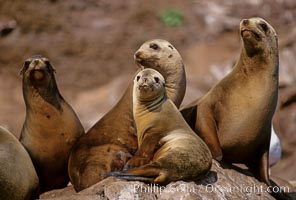
California sea lions, Coronado Islands.
Species: California sea lion, Zalophus californianus
Location: Coronado Islands (Islas Coronado), Baja California, Mexico
Image ID: 02160
Species: California sea lion, Zalophus californianus
Location: Coronado Islands (Islas Coronado), Baja California, Mexico
Image ID: 02160

Bull elephant seal, adult male, bellowing. Its huge proboscis is characteristic of male elephant seals. Scarring from combat with other males.
Species: Elephant seal, Mirounga angustirostris
Location: Piedras Blancas, San Simeon, California
Image ID: 35149
Species: Elephant seal, Mirounga angustirostris
Location: Piedras Blancas, San Simeon, California
Image ID: 35149
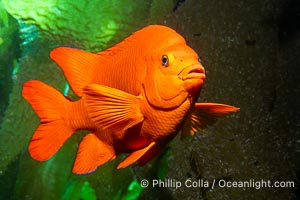
The bright orange garibaldi fish, California's state marine fish.
Species: Garibaldi, Hypsypops rubicundus
Location: Catalina Island, California
Image ID: 40512
Species: Garibaldi, Hypsypops rubicundus
Location: Catalina Island, California
Image ID: 40512

The bright orange garibaldi fish, California's state marine fish.
Species: Garibaldi, Hypsypops rubicundus
Location: Catalina Island, California
Image ID: 40513
Species: Garibaldi, Hypsypops rubicundus
Location: Catalina Island, California
Image ID: 40513

Aerial photo of gray whale calf and mother. This baby gray whale was born during the southern migration, far to the north of the Mexican lagoons of Baja California where most gray whale births take place.
Species: Gray whale, Eschrichtius robustus
Location: San Clemente, California
Image ID: 29001
Species: Gray whale, Eschrichtius robustus
Location: San Clemente, California
Image ID: 29001

Gray whale blowing at the ocean surface, exhaling and breathing as it prepares to dive underwater.
Species: Gray whale, Eschrichtius robustus
Location: Encinitas, California
Image ID: 29045
Species: Gray whale, Eschrichtius robustus
Location: Encinitas, California
Image ID: 29045